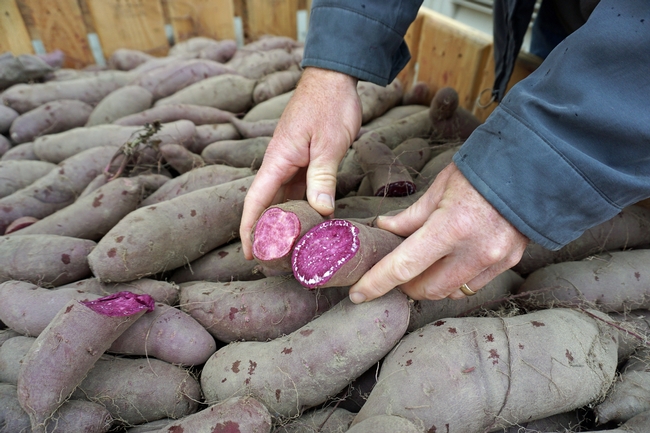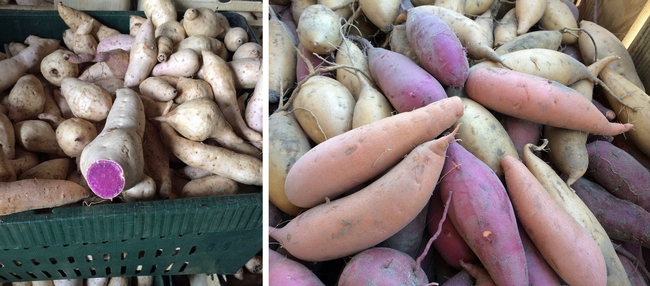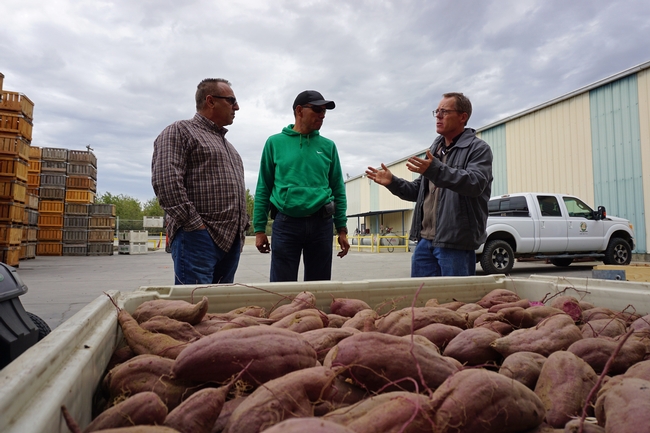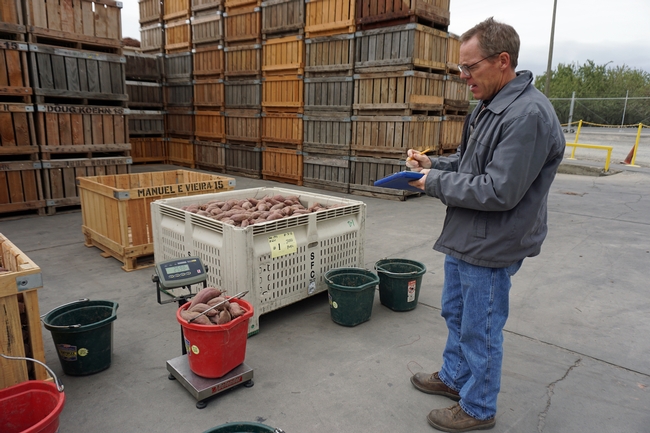Posts Tagged: Scott Stoddard
Vibrant purple sweet potatoes are a healthful Thanksgiving surprise
Candied sweet potatoes – dripping with butter, brown sugar and pecans – or a casserole of mashed sweet potatoes smothered with toasted marshmallows are common sides on the Thanksgiving table. These rich dishes belie the true nature of sweet potatoes, which are nutrient packed, low-glycemic root vegetables that can be a part of a healthy diet year round.
Research by UC Cooperative Extension advisor Scott Stoddard is aimed at making sweet potatoes an even more healthful and attractive food. Stoddard is working with sweet potato growers in Merced County to see if sweet potatoes with dusky purple skin and vibrant purple flesh, called purple/purples, can be grown by more farmers in California. The unusual color and health benefits command a higher price, opening a potentially profitable niche market.
“Purple flesh sweet potatoes have beta-carotene, like the more common orange varieties, plus anthocyanins,” Stoddard said. “It's like eating a handful of blueberries with your sweet potato.”
California is a significant producer of sweet potatoes. About 80 percent of the California crop – 16,000 acres – is grown in Merced County, on farms ranging from 5 acres up to several thousand acres. In 2015, the crop's value in Merced County was $195 million. About 1,000 acres are grown in Kern County and 2,000 acres in Stanislaus County. These locations have the sandy and sandy-loam soils ideal for sweet potatoes to develop their distinctive shape and smooth skin.
Sweet potatoes with purple flesh are not common, but they have been around for quite some time. They are the main type of sweet potato grown in Hawaii, for example. Several years ago, growers in Stokes County, N.C., selected a particularly beautiful and tasty cultivar, naming it the Stokes Sweet Potato and marketing nationwide with Frieda's Specialty Produce. In California, A. V. Thomas Produce in Livingston acquired an exclusive agreement with the company to grow and market Stokes purple/purple sweet potatoes.
“The number of acres of Stokes has really expanded in just a few years,” Stoddard said. "There is a lot of consumer interest in purple-fleshed sweet potatoes."
That doesn't close the door on purple/purples for California's other growers interested in the niche. Stoddard conducts field trials in cooperation with local farmers that include purple/purples. In one trial, 50 types of sweet potatoes of many different colors are being grown to determine whether they have key characteristics needed for local production. From there, he selects a limited number to grow in replicated trials, to determine their potential to produce a high yield, store well, and develop good size, shape, color and flavor. Of these, only one purple/purple made it into the replicated trial.
“In some purple/purples, the flavor can be off, or bitter,” Stoddard said. “We get rid of those right away.”
One of the cultivars in Stoddard's study, which goes by the experimental code number L-14-15-P, was bred in 2014 by Don La Bonte, a plant breeder at Louisiana State University, Baton Rouge. The potato has some good attributes, but lacks the uniform deep purple color of the Stokes variety.
“Unfortunately, it's probably not good enough to displace Stokes,” Stoddard said. “It's a good start, but we have to continue screening purple/purples to find a variety that offers disease resistance, good yield, and consistent deep purple flesh color."
Good eats
Sweet potatoes can be eaten raw or cooked. To eat raw, simply peel, cut into sticks and serve with low-fat ranch dressing or apple sauce for dipping. Grate fresh, uncooked sweet potatoes and add to burritos or tacos or sprinkle on salads for a sweet, nutritious crunch.
Cooked sweet potatoes can be eaten for breakfast, lunch or dinner, skin and all, plain or with a small pat of butter.
Microwaving is a great way to quickly prepare the vegetable. Wash potatoes and pat dry. Prick skin with a knife in 2 to 3 places. Cook on high for 5 minutes. Turn over. Then cook for another 5 minutes, more or less.
UC Cooperative Extension's sweet potato expert Scott Stoddard says he prefers his sweet potatoes baked.
“Baked is way better,” he said. “Baking gives time to convert the starch to maltose.”
Sweet potatoes are mostly starch, but have a special enzyme that breaks down starch into maltose when cooking. Slower cooking in the oven provides time for the conversion, imparting a subtly sweet caramelized flavor.
To bake, preheat the oven to 400 degrees. Line the lower oven rack with foil, then prick sweet potatoes with a fork and place directly on the middle oven rack, above the rack with foil. Bake 45 minutes for sweet potatoes 2 to 3 inches in diameter.
What’s the difference between yams and sweetpotatoes?
Do you know the difference between a yam and a sweetpotato?
“A true yam is not grown in the U.S., it's found in South America,” says Jason Tucker, vice president of the California Sweetpotato Council. Real yams have dry, dark flesh and are not the same plant species as sweetpotatoes, he explained.
“A yam is a sweetpotato, at least for those grown in the U.S.”, says Scott Stoddard, UC Cooperative Extension advisor in Merced County. “The rest of country has predominately just one type of sweetpotato, with tan skin and orange flesh, but in California, we have four marketing classes.”
The four kinds of California sweetpotatoes are
- Jewell, with tan skin and orange flesh
- Jersey, with light yellow skin and white flesh
- Oriental, with purple skin and white flesh
- Garnet, with red skin and deep orange flesh
The red-skinned sweetpotatoes are what many people in the United States call yams.
The California Sweetpotato Council spells sweetpotato as one word because it isn't a potato, it is a different plant species.
Enjoy California sweet potatoes around the clock and calendar
Sweet potatoes are perhaps most familiar in the U.S. smothered with melted marshmallows in a Thanksgiving casserole. But baked, boiled or raw, they can be a healthful part of California cuisine any time of year.
California is a significant producer of sweet potatoes. About 90 percent of the California crop – 18,000 acres – is grown in Merced County, on farms ranging from 5 acres up to several thousand acres. In 2011, the crop’s value statewide was $125 million.
However, you probably won’t find sweet potato farmers at your local farmers market.
“Even smaller growers tend to work with a packing shed and have their crops combined with others and marketed,” said Scott Stoddard, UC Cooperative Extension advisor in Merced County.
A few years ago, when sweet potato fries began showing up at high-end restaurants and fast food chains across the country, the U.S. and the California sweet potato industries overestimated the future growth in sweet potato consumption, Stoddard said. In addition, improvements in growing practices boosted yield per acre, leaving the country with something of a sweet potato glut. Currently, acreage is inching down again as growers balance supply with demand.
Most sweet potato breeding programs are conducted in the South, such as Louisiana and North Carolina, but the characteristics sought in that part of the country are different than California. Stoddard is conducting specialized variety trials in California to select varieties with red, purple or garnet skin.
“In California, we are going for a red-skinned sweet potato,” Stoddard said. “Especially, a red-skinned variety that stores well.”
Some people incorrectly believe that sweet potatoes with moist orange flesh are yams. True yams can be found elsewhere in the world, but in the U.S., a sweet potato is a sweet potato, whether the flesh is orange, yellow or white and whether the skin is tan, dusty pink or garnet red.
Sweet potatoes are a featured California crop in Dirt Fresh News, a monthly newsletter produced by UC Cooperative Extension in Stanislaus County that introduces school children to fresh, locally grown food. The newsletter says sweet potatoes are a good source of potassium, fiber, beta-carotene and vitamins B-6, E and C.
To eat them raw, simply peel, cut into sticks and serve with low-fat ranch dressing or apple sauce for dipping. Grate fresh, uncooked sweet potatoes and add to burritos or tacos or sprinkle on salads for a sweet, nutritious crunch.
Baked sweet potatoes can be eaten for breakfast, lunch or dinner, skin and all, plain or with a small pat of butter.
“Microwaving is a great way to save energy if you are just baking 1 or 2 potatoes,” the newsletter says. “Wash your potatoes and pat dry. Prick skin with a knife in 2 to 3 places. Cook on high for 5 minutes. Turn over. Then cook for another 5 minutes, more or less.”
Following are recipes from the Sweet Potato Council of California:
Warm sweet potato and green bean salad
3 medium sweet potatoes, cooked, pared and cut into ¼-inch slices (about 2 lbs.)
½ pound fresh whole green beans
1 small red onion, halved and sliced
1 clove garlic, minced
2 tablespoons vegetable oil
1 cut watercress springs (optional)
1 tablespoon red wine vinegar
½ teaspoon salt
¼ teaspoon freshly ground pepper
In large skillet over medium-high heat, brown sweet potatoes and cook green beans with onion and garlic in oil until crisp-tender. Remove from heat. Stir in remaining ingredients. Service warm. If esired, top with Parmesan cheese shavings.
Sweet potato Leek Soup
1 bunch leeks, white and light green portion
2 tablespoons butter or margarine
2 fresh sweet potatoes
4 cups water
1 teaspoon salt
1/2 teaspoon thyme
1/2 cup heavy cream
1 tablespoon lemon juice
1/4 teaspoon white pepper
1 pinch cayenne or ground red pepper
Slice leeks and saute in butter until soft. Thinly slice sweet potates; add to leeks; saute 3 minutes. Add water, salt and thyme. Bring to a boil; reduce heat and simmer, partially covered, 20 - 25 minutes, stirring occasionally, until vegetables are very soft. Puree and strain. Add cream, lemon juice, white and red pepper. Adjust seasonings to taste. For garnish, julienne additional leek and sweetpotato into 3/4" strips; saute in 2 tablespoons butter until crisp-tender. Just before serving, stir into soup. Makes 4 to 6 servings.







